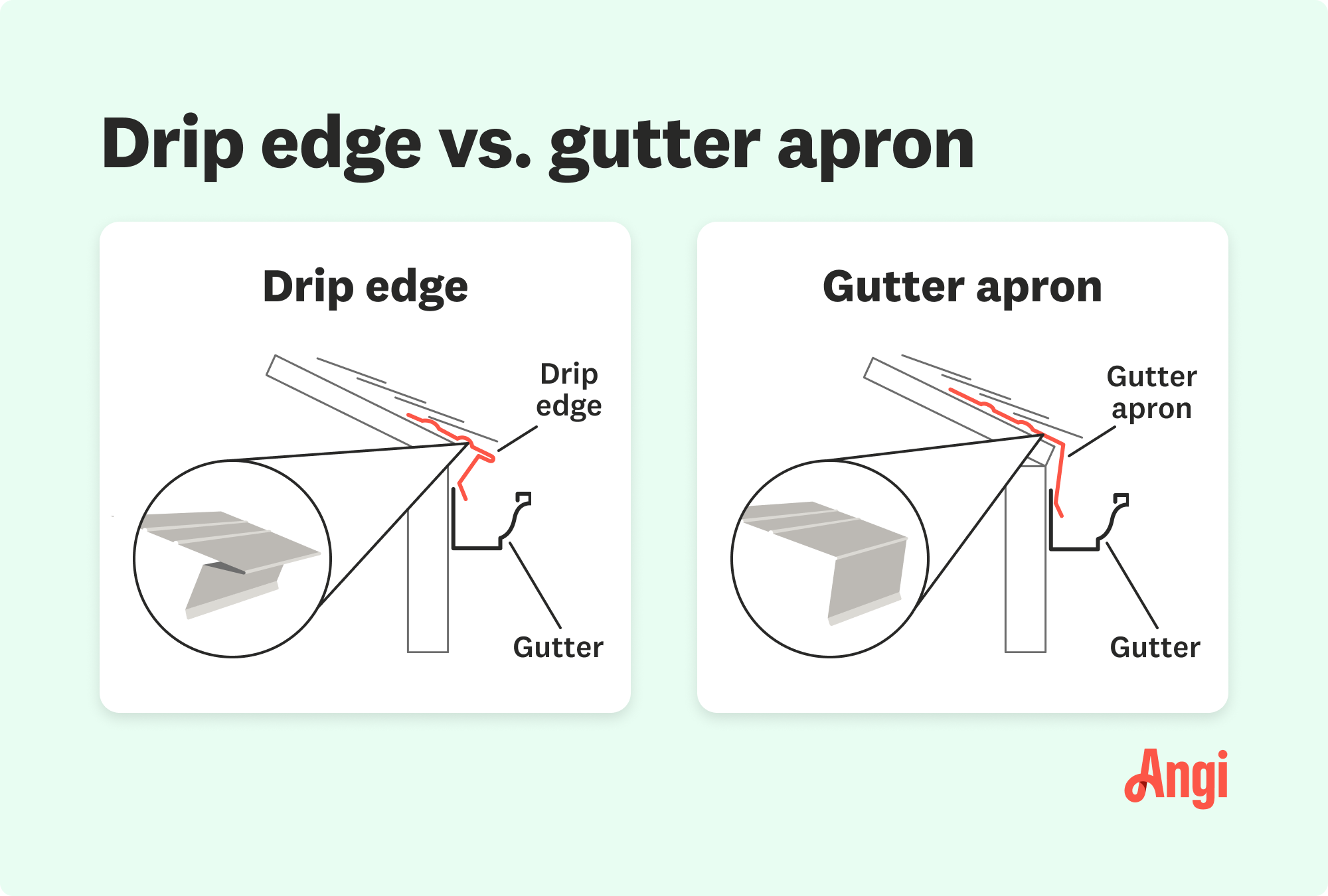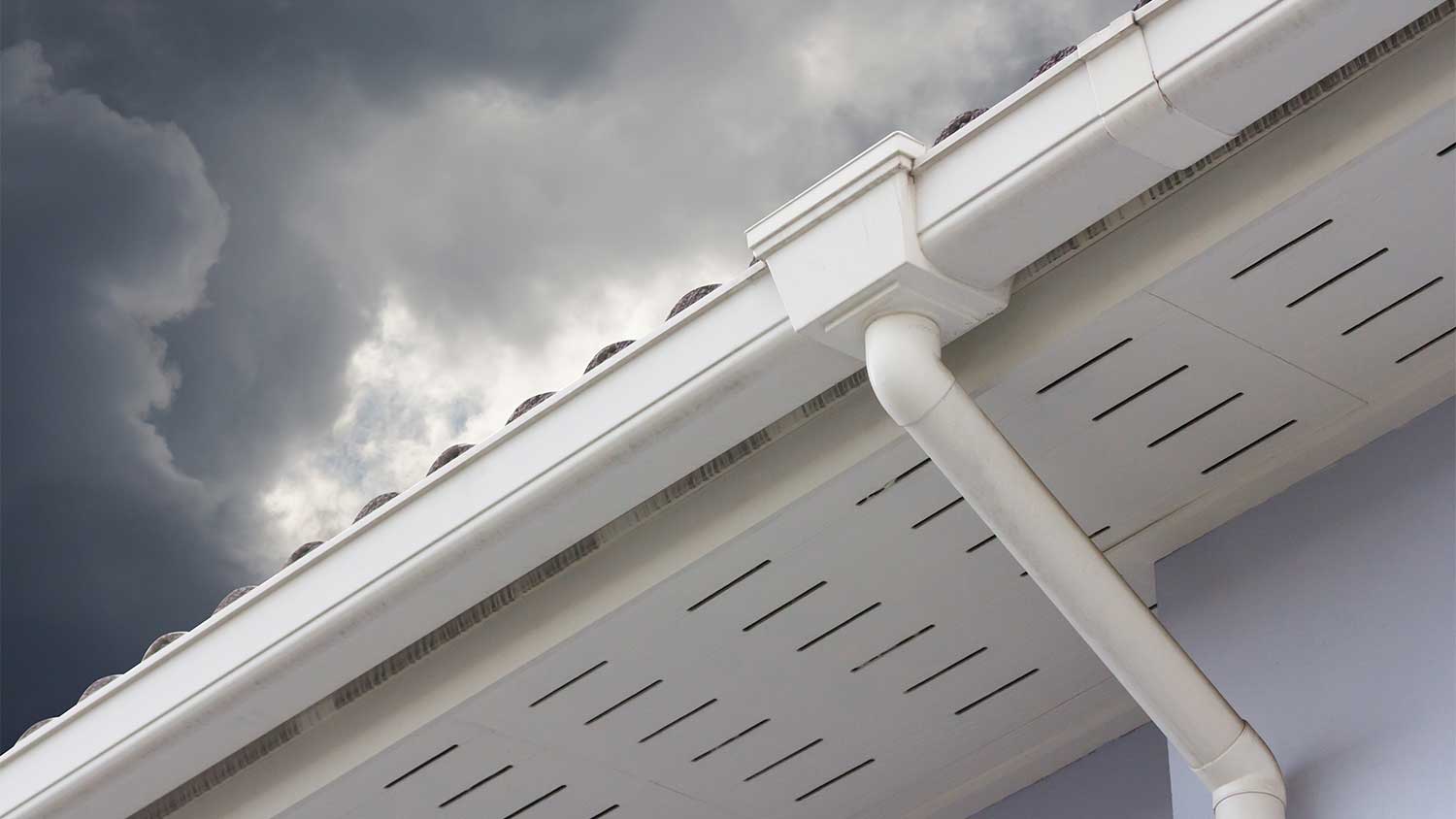Drip Edge vs. Gutter Apron: What’s the Best for Your Home?
Rain, rain, go away—but if you must stay, should you hit a drip edge or a gutter apron today?


Both gutter aprons and drip edges can protect your home from water damage.
Gutter aprons are easier to install during a new roof installation.
Gutter aprons are specifically designed for gutter systems, while drip edges work on roofs with or without gutters.
Gutter aprons and drip edges have similar price points.
Drip edges and gutter aprons can both help to protect your home from water damage while boosting your curb appeal. However, some houses are better suited to drip edges, while others lend themselves more to gutter aprons. Learn the key differences between drip edges and gutter aprons so you can choose the right option for your home.
What Is a Drip Edge?

Drip edges are impervious strips usually made of metal that sit on the edge of a roof to control water flow. They typically sit underneath the first line of shingles, directing rainwater away from the fascia board, aka the trim that runs along the roof's lower edges. The water then goes into the gutters if you have them, or simply away from the roofing components.
Drip edges help prevent water from seeping underneath the roof and into your home, such as your attic space or your basement. They can also improve a home's aesthetics, especially when painted to match or complement the house's design.
Pros
Protects against water damage
Prevents ice dams from forming on the roof's eaves, which protects your roof and gutter system
Potentially prolongs the life span of shingles
Improves exterior aesthetic
Can prevent insects and small critters from making their way under the shingles and into your home
Cons
Not typically included in a standard roof installation
Coding limitations might restrict drip edge installs on older homes
Installation is too complex for most homeowners to tackle themselves
What Is a Gutter Apron?

Like drip edges, gutter aprons are installed on the roof to direct water away from the roof and into a designated gutter system. They're bent pieces of flashing that prevent water from seeping into the roofing components and the home itself, such as the attic and basement.
Typically made of metal, like aluminum or galvanized steel, they have similar pros and cons to drip edges, but gutter aprons are installed along the roof's eaves, and they're specifically designed for gutters, while drip edges are often installed with or without gutters along the roof's sides, or rakes.
Pros
Directs water away from the roof and into the gutters, preventing water damage
Prevents the formation of ice dams
Closes gaps between the gutter and roof, deterring birds and insects from nesting
Can boost your home's curb appeal
Potentially prolongs the life span of gutters
Cons
Likely to increase the overall cost of a roofing project
Usually requires expert installation
Best to install them at the same time you're installing a roof
Drip Edge vs Gutter Apron: Key Differences

While both drip edges and gutter aprons serve similar purposes, there are a few differences between the two that can affect the right choice for your home. For instance, if your roof is already installed, drip edges are likely the best choice.
Installation
Gutter aprons are installed by tucking the top edge of the apron underneath the roofing material and extending the bottom edge to the gutter, filling the gap between the gutter and roof. Drip edges are installed along the roof's trim and usually hang past gutters.
If your roof has many sides and curved edges, gutter aprons will likely look better since drip edges will be more noticeable on many sides. However, gutter aprons are much trickier to install on existing roofs, so if you already have a roof that you're happy with, drip edges are a better option.
Easier installation: Drip edges
Durability
Drip edges and gutter aprons are typically made of the same materials, like steel and aluminum, so they offer comparable durability. But depending on your gutter material, you may need copper drip edges or gutter aprons. Both are highly resistant to rust and weather damage, as well as UV rays.
However, gutter aprons might be slightly more prone to damage if you don't regularly unclog and clean your gutters, so keep your gutters tidy to ensure your gutter aprons' durability. Gutter cleaning costs between $75 and $400 on average.
Better durability: Drip edges
Shape
Drip edges are usually in the shape of an 'L' or a 'T', with the bottom part extending away from the house. Their shape can become apparent on roofs with lots of sides, which is why gutter aprons usually look better on these roofs. Gutter aprons are shaped like an 'L', with the bottom flange being longer than that of a drip edge and connecting directly to the gutter.
For homes with gutter alternatives like rain chains, a gutter apron may not be an option, whereas most homes benefit from having drip edges.
Better shape: Tie
Cost
Drip edges cost between $3 and $15 per linear foot, depending on the style. L-shaped drip edges usually cost between $3 and $10 per linear foot, while T-shaped drip edges cost between $10 and $15 per linear foot. Meanwhile, gutter aprons usually cost between $3 and $10 per linear foot.
Most affordable: Tie
Is It Worth Installing a Drip Edge or Gutter Apron?
Gutter aprons and drip edges are usually worth installing, especially if you live in a region with lots of rain, since they can protect your home from water damage. They're also particularly helpful in houses with very wide eaves, which might cause water to miss the gutters. Plus, homes with wooden fascia are susceptible to rot, so it's a very good idea to install drip edges and/or gutter aprons on these homes to prevent water damage.
DIY vs. Hiring a Pro
Drip edge and gutter apron installations are better left to the pros since they require specialized knowledge, tools, and expertise. Pros usually charge $45 to $75 per hour to install drip edges and gutter aprons, so you can potentially save money upfront by doing it yourself, but when these installations aren't done correctly, it can lead to very costly water damage down the line.
So unless you have extensive roofing expertise, it's best to call a roofing professional near you to handle this job.
Frequently Asked Questions
If you don't install a gutter apron or drip edge, you could experience costly water damage to your roofing, siding, fascia, or even the interior of your home, like your attic. Water is far more likely to leak behind all gutter types or underneath your roofing materials without a drip edge, especially as it’s more of an essential part of your drainage system. In fact, some building codes require homes to have drip edges installed to protect your home from water damage.
Gutter guards should go under the drip edge in most installations. This is not to be confused with installing your gutters in relation to the drip edge. When installing your gutter system, your drip edge should go in front of the gutter to prevent water from leaking behind your roof, where it can cause all kinds of issues for your roof and surrounding areas.
Gutters overflow in heavy rain for several reasons. The main reasons why your gutters could be overflowing in heavy rain include:
Not enough downspouts to effectively remove water from your gutters
Too small of a gutter width—the average gutter size is four to six inches
Clogged gutters
Incorrect slope
If you believe your gutters were installed incorrectly, it’s a good idea to know who to call for gutter leaks. Speak with a local gutter specialist to get to the bottom of your gutter system to stop water from flooding your property or yard ASAP.





- Roof Drip Edge Types: What to Know About Each One
- Is Your Gutter in the Right Place? Here's What to Know
- 6 Gutter Placement Tips for Hanger Spacing, Slope, and More
- Top 10 Gutter Alternatives [2024 Guide]
- Gutter Cleaning 101: What Does It Include and Why Is It Important?
- 10 Signs Your Gutters Were Installed Incorrectly
- Importance of Gutter Slope to Your Home
- 5 Types of Gutter Hangers for Your Home
- Why Is Water Leaking Between the Gutter and Fascia?
- Who Do You Hire to Clean Your Gutters?










